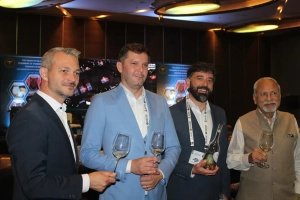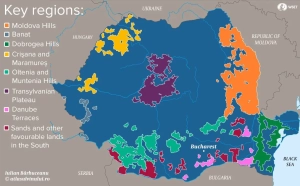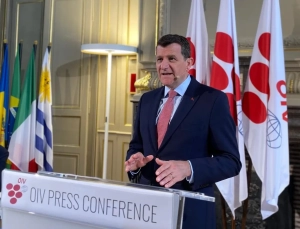From Archives (2007): Bruce Cakebread of Cakebread Cellars, California

Posted: Sunday, 25 June 2023 14:29
From Archives (2007): Bruce Cakebread of Cakebread Cellars, California

Bruce Cakebread is the President of Cakebread Cellars. Located in the middle of Napa Valley, between Oakville and Rutherford, the company was founded by his father Jack Cakebread, a gifted photographer and owner of an auto garage in Berkeley. He had come to Napa Valley about 35 years ago for a photo shoot for the coffee-table book, The Treasury of American Wines. He loved the place so much that he and his wife Dolores decided to buy land for grape growing, and settled down here for good.
Bruce was recently in Delhi, visiting various Cakebread customers of Brindco which imports these wines as part of a bouquet of California wines that include Joseph Phelps, St. Francis and Benziger, distributed through Kobrand, one of the biggest family owned wine and spirits distribution companies in the US. DelWine had an opportunity to chat with him and also taste some of his wines and later enjoy some more with dinner in the evening at Masala Art Restaurant.
We know now how your winery was started. How big have you grown?
When my dad started making wines in 1973, he started with 4 barrels and produced 150 cases in the first year. Now we make 90-100,000 cases a year. From the initial parcel of 22 acres we have grown to a total of 425 acres of land on 13 sites in Oakville, Rutherford, Howell Mountain, Anderson Valley, Carneros and of course, Napa. We have recently bought 120 acres more.
Do you make wine from your own grapes or buy from others too?
We do buy grapes from surrounding vineyards, including many well-known growers of superior Napa Valley grapes. With the current re-plantations going, I would say 50% of our grapes are bought.
 How can you control quality in that case?
How can you control quality in that case?
We have a strong and long relationship with our growers. In many cases, we have been doing business with same farmers for over 30 years. We keep the quality checks and they know that for long term relationship, it is important to have the grape quality maintained at superior level. Some of our select wines are made from select parcels of our own vineyards.
How long have you been in the wine business?
I started working with him in 1977. After doing my degree in viticulture and enology from UC Davies in 1977, I was given the responsibility as a winemaker by my dad in 1979. I carried on with this assignment till 2002 when I was promoted to become the President.
Therefore, is wine business totally a family affair?
Bruce is the youngest of three brothers. The middle brother Dennis looks after the sales in the US and Canada while the eldest Steve runs an IT business and is not involved in the wine business. Father Jack still spends some time at the winery. Mother Dolores looks after the cuisine and facilities management.
But winemaker is an outsider, Julianne Laks who had been assisting Bruce for a number of years.
Are you focussed on Cabernets only?
We have three flagship products really. Sauvignon Blanc has been there for 30 years and is our forte. We have also concentrated on Chardonnay. Cabernet Sauvignon, of course, is our passion.
How well do your wines age?
Normally they age well from 7-12 years. Some of our wines in the early eighties are still drinking pretty well though. We like our Chardonnays also to mature for a few years to attain complexity.
How would you rate the Cakebread and Napa vintages?
 Before I could say ‘vintages’, Bruce started rattling off the quality of each vintage since 1980, just a few years after their first vintage. His evaluation?
Before I could say ‘vintages’, Bruce started rattling off the quality of each vintage since 1980, just a few years after their first vintage. His evaluation?
1980: great vintage. Still drinking nice.
1981: Early harvest. On August 10. Warm vintage. Past its prime. Should be consumed now.
1982: Wet vintage
1983: Light vintage
1984-87: Good vintages
1988: Lot of acidity
1989: Wet vintage
1990: Great
1991: Chardonnay Reserve did very well- doing ok even after 15 years.
1992; Moderate year
1993; Light vintage
1994: Cool vintage. Aging gracefully
1995: Still tight. Needs time to age. A little complicated to comprehend.
1996; Very nice vintage
1997: Every one claims wines are aging well. I think it should be drunk sooner than later. Hot vintage.
1998: Cool vintage. But lighter vintage. Aging gracefully.
1999: Small crop. Too intense. Not my favourite vintage.
2000: Lighter vintage. Less tannin. One dimensional vintage
2001: Good structure of the vintage.
2002: Drinking nice. Good structure.
2003: Strong tannins present. Fruit is in the background. I hope the tannins mellow down nicely as it ages and the fruit stays. Very small crop
2004: Warm vintage. Drink sooner. Very small crop.
2005: Large crop. Balanced wine. Will age nicely. Normal crop.
2006; Coolest vintage in 5 years. We hope to balance tannins with fruit. Normal crop.
2007: ?
What do you think of global warming?
It is a serious issue that is affecting us like everyone else. And everyone has to do his bit to make sure it does not get out of hands. We see that gradually it is affecting us. But we are taking steps to minimise its impact. We are concentrating on reducing waste, reducing water use by calculating how much of water is needed for different blocks of land. We are using more greens and are environment conscious, more than ever before.
You spend a lot of time and efforts on food in your company. Why so?
We understand the importance of food and wine together. Just like grape quality is essential for good wine, we understand that great cooking starts with the best ingredients. We have a resident chef, Brian Streeter who has been highlighting various recipes that match with each of our wines. Cakebread Cellars Cookbook lists many such recipes.
Can you explain to us the American harvest Programme you have it during the second week of September, around the harvest time?
Every year, around the same time we host what we call the American Harvest Workshop. It is a food and wine programme in which we invite chefs from the US.
The objective is to acquaint the chefs about the awareness and appreciation of American viticulture and food products.
We are already into its 21st year. We also hope to get an Indian chef for this programme this year or the next.
Wines of Cakebread Cellars:

We had the pleasure of tasting some of the fine wines at the dinner hosted by the Taj Palace at Masala Art where the Indian cuisine takes an entirely different meaning. Not only is the food healthy due to the use of olive oil (perhaps still the only restaurant in town using it for Indian cooking) but it is light on the stomach and extremely wine-friendly, as we discovered yet another time.
Sauvignon Blanc 2005 was fresh, zesty, fruity and got you into the right mood. The taste lingers on in your mouth and one needed to clean the palate for the Chardonnay 2005 which I found crisp and having balanced acidity but a bit too oaky. As Bruce had explained to me earlier in the day at the tasting, ‘we like to age in oak barrels because this helps age the wine and make it more complex over the years.’ The oakiness is supposed to mellow down over the years like tannins, I was told.
The oakiness did get subdued with the food and my fear that it would interfere with the food was unfounded. The tandoori shrimp tamed it well and yet let it impress with its long after-taste.
Merlot 2003 was a good match with the chicken kebab, and the gehloti, and the Cabernet 2004 though very young and fairly tannic matched the lamb extremely well.
 The darling of the evening was the Benchland Select Cabernet Sauvignon 2003 . It is a 100% cabernet from Oakville and Rutherford. Served with the mutton pullao, it was perhaps not the best paring because merlot handled the spices much better. But it was truly a smashing wine. One could trace any number of concentrated flavours including melting chocolate, cacao and dark berries. It danced on your mid palate and you didn’t want it to swallow but when you did, it left a lasting impression on your palate. The tannins were so soft and rounded that though still very young, one could drinking on.and on. This is precisely what we did.
The darling of the evening was the Benchland Select Cabernet Sauvignon 2003 . It is a 100% cabernet from Oakville and Rutherford. Served with the mutton pullao, it was perhaps not the best paring because merlot handled the spices much better. But it was truly a smashing wine. One could trace any number of concentrated flavours including melting chocolate, cacao and dark berries. It danced on your mid palate and you didn’t want it to swallow but when you did, it left a lasting impression on your palate. The tannins were so soft and rounded that though still very young, one could drinking on.and on. This is precisely what we did.
At US $98 it is worth every penny. Unfortunately, as I found out later, there are not many of these bottles going around. Out of 500-1000 cases crafted annually, only 6 bottles (not cases) are allocated to India. I am not sure if the 4-5 bottles that were polished off that evening, came out of this quota.
If we left the restaurant well past its closing time, it was because the last bottle of the Benchland fished out magically by Thomas Sauzet, Brindco’s sommelier, who was patiently pouring for the evening. It was also because Lewis Johnstone , the Director of Kobrand International, who had also been visiting India from London , had to catch the early morning flight to Shanghai.




